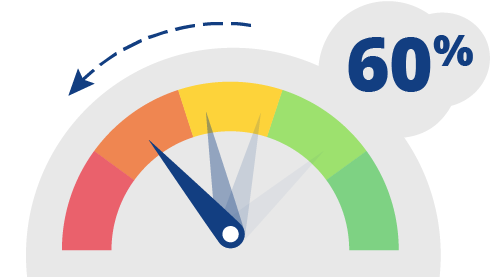The Hidden Cost of Workplace Stress: Impact on Employees and Productivity
by Janelle BeckWiley Workplace Intelligence
Stress. We’ve all felt it at one point or another. Whether in our personal or professional lives (or often a potent combination of both), we have all experienced the pressure that comes when life’s demands start to feel like they’re a bit too much. The rollercoaster that organizations have been on in recent years have no doubt contributed to overall stress levels. It often feels like just when people start to settle down from one major disruption, another comes along to throw the newly acquired stability out the window, and this constant upheaval has had a major impact on stress levels at work. Our recent research found that more stress at work equals less productivity.
Reflecting on how the world of work has changed since 2020, it’s no wonder people are feeling overwhelmed. From the mass move to remote work and back again, to economic turmoil and shifting priorities, people are really starting to feel it. With reported record low engagement and record high stress, Wiley Workplace Intelligence wanted to understand how people are feeling right now, what it means for organizations, and ultimately – what people can do to try to regain some equilibrium in this rapidly changing environment.
Stress Levels Hit Record Highs
Wiley Workplace Intelligence surveyed 2,002 people and found that an extraordinary 95% of respondents report that they are currently experiencing stress in some form. Stress is described as a state of mental or emotional strain resulting from adverse or demanding circumstances and can be caused by a number of factors like work pressure, personal or family issues, or significant changes.

36% Report Experiencing Severe Stress
Of the 95% of people who reported experiencing stress, 36% of those reported experiencing severe levels. Half of all respondents shared that their stress has significantly increased in the last six months. This could be for a variety of reasons. Significant changes in the world of politics, the recent push back to the office, and economic instability causing rapid priority changes in organizations all contribute to a tense environment that impacts daily wellbeing.
Stress can present in a variety of ways, from emotional to physical. Whether it’s irritability or a lack of focus, or more physical manifestations of stress like headaches, muscle tension and fatigue, stress, especially elevated levels of stress, can have a significant impact on daily life, productivity, and overall functioning, and that impact extends to the overall health of your organization.
Impacts of Stress on Employees
89% Report Emotional Symptoms
82% Report Physical Symptoms
77% Impact on Effective Communication
72% Impact Quality of Work
Despite these significant numbers, respondents are sure to add that they do meet their deadlines and continue to perform at work, but it isn’t without challenge. Balancing ongoing stress with productivity can be difficult. Whether it is external challenges related to global instability, personal challenges related to health, pets, or families, or work factors that feel increasingly out of your control, it all adds up to be a big red flag for organizations and the time is now to invest in the wellbeing of your people.
Top Three Reasons for Increased Stress at Work
While organizations do not always have the ability to calm the chaos in the world at large, leaders can have a big impact on the wellbeing of their people at work.
Over half of our respondents (60%) shared that the high levels of stress they are currently experiencing have a negative impact on their productivity. And it’s not hard to imagine why.
The top reason our respondents reported increased stress is due to constant change. Whether it’s anxiety about an impending email notifying employees about a new return to office mandate (which means having to, yet again, respond with more logistical changes at home and in your family life, potential financial stress from parking, commuting, childcare costs, etc.), or news of lay-offs, or the implementation of another AI tool, it’s important to acknowledge that tensions are high and each of these decisions doesn’t happen in a vacuum. Each business decision has the potential to impact employee stress levels and wellbeing.

60% say high levels of stress negatively impact productivity.
The second reason individuals reported increased stress is having too many responsibilities. Having too many responsibilities can lead to feelings of overwhelm, especially when they are in areas where people feel less competent. Whether it’s due to restructuring, upskilling, or reskilling people often feel stressed from having too many responsibilities, especially when time is limited, and expectations are high. The pressure to meet high standards in rapidly changing environments can be daunting, and the lack of control over one’s workload can increase stress.
Lack of clarity was the third reason respondents have had increasing stress levels. Due to the constant change in the world of work, and the world at large, lack of clarity can cause stress because it creates uncertainty and confusion. When people don’t have clear instructions or goals, they may feel unsure about what is expected of them, leading to anxiety and frustration. This uncertainty can make it difficult to prioritize tasks and make decisions, resulting in a sense of being overwhelmed.
What You Can Do
Our respondents shared three top things organizations can do now to help mitigate employee stress, and while they range from easily implemented (support and communication) to more complex (increase hiring), they are an evidence-based starting place that can have an immediate impact on the wellbeing of your people.
Three Ways to Reduce Stress at Work

Increase Resources

Better Support for Teams

Clear Communication
Adequate Staffing: Ensuring that there are enough employees to manage the workload is crucial for reducing stress. When organizations are appropriately resourced (or as close to as possible), it prevents existing employees from being overwhelmed with too many tasks. This not only helps in distributing the workload more evenly but also allows employees to focus on their responsibilities without feeling overwhelmed. Adequate staffing levels can lead to a more balanced work environment, where employees can perform their duties efficiently and maintain a healthier work-life balance, thus reducing stress. Being appropriately staffed can also allow employees to complete their tasks more thoroughly, increasing focus and therefore promote higher quality work.
Better Support for Teams, Workloads, and Employees: Providing better support for teams and managing workloads effectively can significantly reduce stress. Organizations can achieve this by offering resources such as training, tools, and technology that help employees perform their tasks more efficiently. Additionally, fostering a supportive culture where employees feel comfortable seeking help and collaborating with their colleagues can enhance teamwork and reduce the pressure of individual workloads. Regular check-ins and feedback sessions can also help identify and address any issues before they escalate, ensuring that employees feel supported and valued.
Clear Communication: Clear communication is essential for minimizing stress in the workplace. When organizations communicate expectations, goals, and instructions clearly, employees are less likely to feel confused or uncertain about their tasks. This clarity helps in setting realistic deadlines and priorities, enabling employees to manage their time and efforts more effectively. Regular updates and open channels of communication also ensure that employees are informed about any changes or developments, reducing the anxiety that comes from uncertainty. By fostering an environment of transparency and open dialogue, organizations can create a more cohesive and stress-free workplace.
While it may not be possible to control the changes in the world at large, as leaders you have the power to create an organizational culture that prioritizes employee wellbeing and decreases stress. After all, the less stressed the more productive, and successful in the long run, your organization will be.
About the Author
Workplace Intelligence is a monthly newsletter put together by Wiley, an American multinational publishing company who advocates for advancement, empowering knowledge-seekers to transform today’s biggest obstacles into tomorrow’s brightest opportunities.
Contents of this article remain the property of the author and/or publisher.



